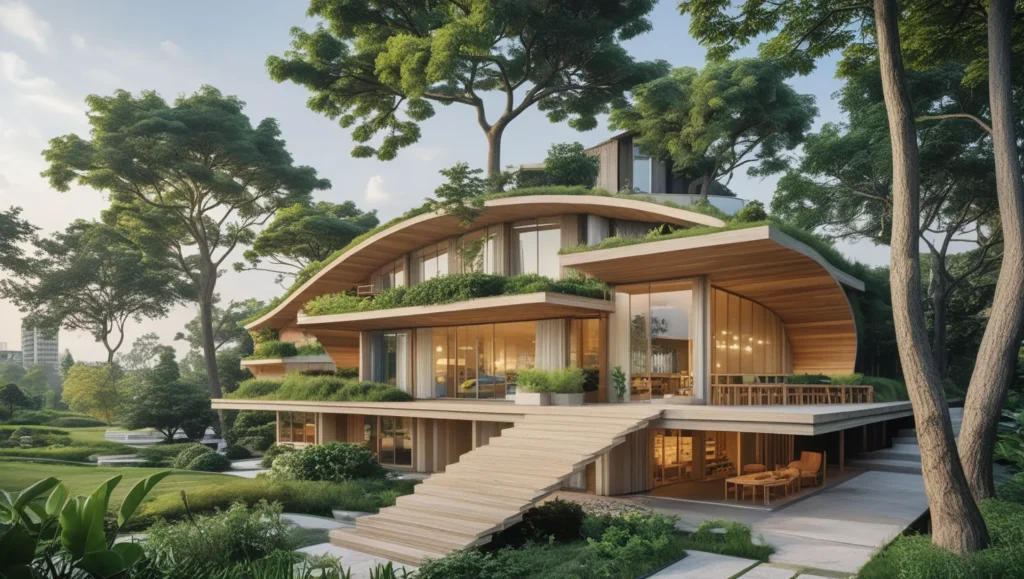Rise of Eco Friendly Architecture
In recent years, eco-friendly architecture has become more than just a trend; it has evolved into a critical approach in reshaping the built environment for a sustainable future. As the world faces pressing challenges related to climate change, resource depletion, and rapid urbanization, eco-friendly architecture offers solutions that prioritize environmental responsibility without compromising design, functionality, or comfort. This shift in architectural practices is not only transforming buildings but also reshaping the way we live and interact with the environment. Rise of Eco Friendly Architecture
What Is Eco-Friendly Architecture?
Eco-friendly architecture, also known as sustainable or green architecture, is an approach that focuses on minimizing a building’s environmental impact. It integrates energy-efficient systems, uses sustainable materials, reduces waste, and incorporates design features that are sensitive to the natural environment. The goal is to create spaces that are resource-efficient, healthier for occupants, and have a positive impact on the environment. Rise of Eco Friendly Architecture
The philosophy behind eco-friendly architecture is rooted in the idea of “green building,” which combines innovative design and technology to reduce carbon footprints. By utilizing sustainable practices, eco-friendly architecture strives to achieve harmony between human activities and the planet’s resources.
Why Eco-Friendly Architecture Matters
- Reducing Carbon Footprints:
Buildings are responsible for nearly 40% of global carbon emissions due to energy consumption for heating, cooling, lighting, and powering electronic devices. Eco-friendly architecture seeks to reduce this by incorporating renewable energy sources such as solar panels and wind turbines, and improving insulation and energy efficiency. - Conserving Natural Resources:
Sustainable architecture focuses on conserving resources such as water and raw materials. It encourages the use of recycled and repurposed materials, reducing the need for new resources. Innovations like rainwater harvesting, greywater recycling, and smart irrigation systems further contribute to preserving water and minimizing waste. - Enhancing Health and Well-being:
Eco-friendly buildings prioritize natural ventilation, daylighting, and non-toxic materials, which can improve indoor air quality and promote a healthier living environment. As a result, occupants are less likely to experience respiratory problems, allergies, and other health issues commonly linked to poor indoor environments. - Long-term Economic Benefits:
While eco-friendly buildings may have a higher initial cost, they tend to offer significant savings in energy and maintenance over time. The use of energy-efficient appliances, better insulation, and natural light reduces utility bills and makes the building more cost-effective in the long run.
Key Features of Eco-Friendly Architecture
- Sustainable Materials:
Choosing materials that are environmentally friendly is one of the cornerstones of green building. This includes materials that are locally sourced, non-toxic, recyclable, or biodegradable. Bamboo, reclaimed wood, recycled steel, and lowRise of Eco Friendly Architecture -VOC paints are just a few examples of sustainable materials used in modern architecture. - Energy Efficiency:
One of the primary goals of eco-friendly architecture is energy efficiency. This can be achieved through the use of high-performance insulation, energy-efficient windows, and energy-saving appliances. Passive design strategies Rise of Eco Friendly Architecture such as optimizing natural light, air circulation, and thermal mass can also reduce the need for artificial heating and cooling. - Solar and Renewable Energy:
Solar panels are one of the most widely used renewable energy sources in eco-friendly architecture. Buildings are designed to harness the power of the sun, with strategically placed solar panels that can generate electricity or provide Rise of Eco Friendly Architecture hot water. Wind energy and geothermal heating and cooling systems are also gaining popularity in eco-friendly buildings. - Water Conservation:
Eco-friendly buildings often incorporate water-saving technologies like low-flow faucets, rainwater harvesting systems, and greywater recycling. These Rise of Eco Friendly Architecture features help reduce water consumption and promote the responsible use of water resources. - Indoor Air Quality:
Using materials that emit low levels of harmful chemicals is essential for maintaining good indoor air quality. Eco-friendly architecture also emphasizes proper ventilation, which allows for the circulation of fresh air and reduces the buildup of indoor pollutants. The incorporation of plants and greenery is Rise of Eco Friendly Architecture another way to naturally purify the air and enhance well-being. - Green Roofs and Vertical Gardens:
Green roofs and vertical gardens not only provide a beautiful and aesthetic Rise of Eco Friendly Architecture addition to buildings but also contribute to environmental sustainability. They reduce the heat island effect, promote biodiversity, and help with storm water management by absorbing rainwater.
Global Examples of Eco-Friendly Architecture
- The Edge, Amsterdam:
The Edge is one of the most sustainable office buildings in the world. It features smart design elements such as solar panels, a green roof, and efficient heating and cooling systems. The building also incorporates energy-efficient lighting, natural ventilation, and a rainwater harvesting system. - The Crystal, London:
The Crystal is a sustainable building in London that serves as a hub for innovation and sustainability. It features a green roof, energy-efficient systems, and water conservation technologies. The building is also designed to use solar power and has a rainwater collection system. - Bosco Verticale, Milan:
Bosco Verticale, or “Vertical Forest,” is an iconic example of vertical gardens in urban architecture. The two residential towers in Milan are covered in over 9,000 trees, 13,000 shrubs, and 5,000 plants. The project not only contributes to biodiversity but also improves air quality in an urban setting. - Solar Settlement, Freiburg, Germany:
The Solar Settlement is a residential complex that generates more energy than it consumes. It features passive solar heating, solar panels, and energy-efficient buildings. The project is a model for sustainable living and showcases the potential of green architecture for entire communities.
Challenges and Future of Eco-Friendly Architecture
While eco-friendly architecture is rapidly gaining traction, several challenges still exist. The initial cost of sustainable materials and energy-efficient systems can be high, which can be a barrier for some developers. Additionally, there is a lack of widespread awareness about the long-term economic and environmental benefits of green buildings. Rise of Eco Friendly Architecture
However, as demand for sustainable practices continues to rise, governments, developers, and architects are working together to overcome these barriers. Incentives, such as tax credits and grants, as well as advances in green technology, are helping to make eco-friendly buildings more accessible. Rise of Eco Friendly Architecture
The future of eco-friendly architecture looks bright, with innovations like 3D-printed homes, green skyscrapers, and fully sustainable smart cities on the horizon. The integration of nature into urban spaces, a shift toward circular economy principles, and advancements in materials science are just some of the trends that will continue to shape the future of sustainable architecture. Rise of Eco Friendly Architecture
Final Thoughts
Eco-friendly architecture is more than just a design choice; it’s a fundamental approach to creating a better world. As awareness of environmental issues grows and technology continues to evolve, sustainable buildings will become the standard in cities worldwide. Embracing eco-friendly architecture is an essential step toward creating a more sustainable future, one where both people and the planet thrive. By supporting green building practices, we can reduce our environmental impact, conserve resources, and pave the way for healthier, more resilient communities. Rise of Eco Friendly Architecture

